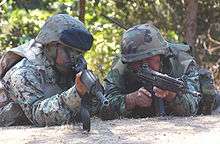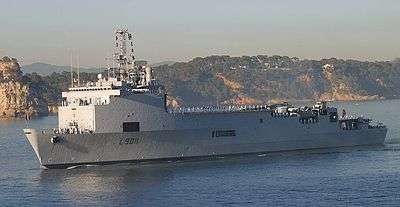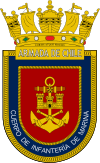Chilean Marine Corps
| Chilean Marine Corps | |
|---|---|
|
Chilean Marine Corps Crest | |
| Active | 1818-Present |
| Country |
|
| Branch | Chilean Navy |
| Type | Commando |
| Role |
Amphibious warfare Special Forces support Military bands service |
| Nickname(s) | Cossacks |
| Motto(s) | Fortis Atque Fidelis |
| Colors | Red Scarlet & Yellow |
| March | Torreones de Oro, Honors to the Fallen, Marine Infantry Hymn |
| Anniversaries | 16 June 1818 |
| Website | http://www.armada.cl/ms/cuer_infa/index.html |

The Chilean Marine Corps (Spanish:Cuerpo de Infantería de Marina or CIM) is an entity of the Chilean Navy special forces which specializes in amphibious assaults.
History

The Marine Corps was born with the establishment of the first armed forces of an independent Chile: the Corps was founded by Don Bernardo O'Higgins Riquelme on June 16, 1818, through a Supreme Decree. However, the predecessor of the Marine Corps in Chilean history may be found in the early efforts of patriot revolutionaries against Spain in challenging royal control of the sea. In fact, a force of twenty-five soldiers Cazadores de los Andes, aboard the brig "Aguila" constituted the embryo of the Marines, who have since participated in all the actions to which Chilean warships have been committed.
O'Higgins's Supreme Decree described the role of the Marines: "these people will fire rifles from the deck, [and] will handle the machete in boardings and bayonet and cannon in landings." The Marine Corps thus became an indispensable complement to the sailors of the Navy, whose primary responsibility was to properly maneuver their craft during combat.
Mission and later history
"To provide the operational commander of Marines forces organized, equipped and trained, with the aim of contributing to the projection of naval power, to defend the coast and internal security and institutional."
In other words, it consists mainly of amphibious assault force, coastal defense force, special forces, support organs and garrisons.
It also organizes, equips and trains them to develop in times of conflict operations and actions that are characteristic over territory or where necessary, as irreplaceable component of the naval power of the nation, contributing effectively to safeguard the sovereignty and territorial integrity.
The Marines were to move in line with the means available to the Chilean Navy. The advent of steam ships and the longer range of the artillery, and many other circumstances, ensured fighting occurred at a greater distances; Collisions were becoming increasingly impractical and rifles on the deck, unnecessary. For that reason was the predominant role of gunner and the Marine Corps became Artillery Battalion of the Navy.
In 1866, the members of this battalion had to cover the garrisons of warships and fortifications on the ground. In such condition they all subsequently participated in all actions of the Naval War of the Pacific, displaying extraordinary courage and aggressiveness.
This war highlighted the Chilean Disembark in Pisagua, the first amphibious assault of the modern era. Amphibious operations were conducted on November 2, 1879, where the Chilean squadron provided escort and naval fire support, while the landing forces composed by 9,000 men landed in Caleta Pisagua and captured the position in a fast offensive action, taking only 4 hours. The Peruvian forces, after a strong initial resistance, were defeated due to the strong and sustained aggressiveness shown by the Chilean soldiers.
Since 1887, it functions as coastal artillery. Such a definition of the mission led to the updating of Organic Regulations of the Corps, which in 1938 was defined as Coastal defense.
Beginning in 1964, the Corps was completely reorganized and refocused, being renamed the Marine Corps and constituting a modern amphibious force which has continued to evolve in line with the requirements of the institution to have a real amphibious capacity and capable of contributing on projecting naval power over hostile territory
The other mission of the Marines is the protection, maintenance and monitoring of the naval facilities, the most famous being The Lions Gate with its security unit under the order and security detachment of the Marines in Talcahuano (main naval base Chile) is responsible for maintaining order and security inside the naval base and naval populations.
Organization
The Chilean Marines are organized into two battalion-sized detachments (Destacamento de Infantería), two full-time battalions plus support units. As of 2013 they are now a full division-sized formation of 2 brigades plus independent units.
Expeditionary Amphibious Brigade
Formed recently, this brigade forms the amphibious component of the Corps with a mission to support the armed services in peacekeeping missions of in times of conflict and can do operations adaptable to any terrain possible. The brigade is headquartered in the Marine Corps bases in Concon and Talcahuano.
- Brigade Headquarters'
- Headquarters Company
- 21st Marine Battalion "Miller"'
- 31st Marine Battalion "Aldea"
- 41st Marine Combat Support Battalion "Hurtado"'
- 51st Marine Logistic Battalion
Protection Forces
The two remaining Marine Detachments plus smaller independent units form the Protection Forces of the Corps. Their duty is the protection of national territory and all naval bases and installations.
- 1st Marine Detachment "Lynch" (Destacamento de Infantería de Marina Nº 1 Lynch), stationed at Fort Condell, Punta Gruesa south of Iquique (4th Naval Zone): Its main function is to provide artillery and coastal defense, with batteries of howitzers and Excalibur missiles. It depends directly on its respective Naval Zone, due to its border location.
- 4th Marine Detachment "Cochrane"(Destacamento de Infantería de Marina Nº 4 "Cochrane"), located in Río de los Ciervos south of Punta Arenas (3rd Naval Zone): This Marine Detachment has similar characteristics to the 1st Marine Detachment because of its border location. It specialises in coastal defense and the use of artillery.
Other units
Each zone has a "Naval Detachment of Order and Security" (Destacamento de Orden y Seguridad in Spanish) that acts as base garrison unit and military police force. There are smaller detachments in remote areas like Puerto Williams and Isla de Pascua. The CIM also is responsible for the protection of the commander in chief of the Navy and contributes a section to the security of the facilities of the Ministry of Defense in Santiago. The corps also operates the Marine Infantry School "Commander Jaime Charles" together with the Naval Educational Command of the Navy, which fully owns and maintains the institution, and it is a part of the Naval Polytechnical Academy.
The Band Service of the Chilean Navy personnel are from the Marine Corps, particularly the military bands of the Naval School "Arturo Prat", the Seaman Training School "Alejandro Navarette Cisterna" and the Naval Polytechnic Academy. Like their counterparts in the British Royal Marines Band Service, they operate not just as headquarters bands for the 5 naval zones and 4 marine battalions, plus as in-house band for the Marine Infantry School and for the BE "Esmeralda", but also as bands for the naval educational institutions, even though in the naval bands sailors and officer/NCO cadets fill the ranks of the Corps of Drums which are attached to the bands and are composed of snare drums, fifes and bugles (in the marine bands soldiers of the Marines fill the Corps of Drums rosters). They all report to Headquarters, Chilean Marine Corps. These bands date back to the mid 19th century when the Marine Artillery band was raised to provide musical support for the Navy.
Chilean Marines equipment
Amphibious warfare ships


| Vessel | Pennant number | Origin | Type | Class | In service | Notes |
|---|---|---|---|---|---|---|
| Sargento Aldea | LSDH | |
- | Foudre class | 1 | -TCD Foudre L9011 |
| Aquiles | AP-41 | |
- | - | 1 | - |
| Rancagua | LST-92 | |
- | BATRAL class | 1 | - |
| Chacabuco | LST-95 | |
- | BATRAL class | 1 | - |
| Elicura | LSM-90 | |
- | Elicura class | 1 | - |
| Orompello | LSM-94 | |
- | Elicura class | - | Decommissioned December 2012 |
Vehicles
| Name | Type | In service | origin | Note |
|---|---|---|---|---|
| FV101 Scorpion | Reconnaissance vehicle | 45 | | |
| Bandvagn 206 | tracked articulated, all-terrain carrier | 40 | | |
| HMMWV | Light Utility Vehicle | 60 | | |
| Petit Véhicule Protégé | Light Utility Vehicle | 15 | | |
| KIA KM 250 | Military truck | | ||
| KIA KM 420 | Light Utility Vehicle | | ||
| KIA KM 450 | Off-road vehicle | | ||
| KIA KM 421 | Ambulance | |
Artillery and Air-defense systems
| Name | Type | In service | origin | Note |
|---|---|---|---|---|
| Soltam M-71 (G-4) | Howitzer | 24[1] | | |
| KH-178 | Towed Howitzer | 16 | | |
| Excalibur Battery | Anti-ship missile system | 4 | | Uses Exocet MM-38 |
| M252 mortar | Mortar (weapon) | | ||
| Blowpipe (missile) | Man-portable air-defense systems | | ||
| Bofors 40 mm | Anti-aircraft artillery | | ||
| Oerlikon 20 mm cannon | Anti-aircraft artillery | |
Infantry Weapons
| Name | Type | caliber | origin | Note |
|---|---|---|---|---|
| Heckler & Koch HK33 | Assault rifle | 5.56 mm | | Being replaced by FN SCAR-L[2] |
| M4 carbine | Assault rifle | 5.56 mm | | Special Forces. |
| SCAR-L | Assault rifle | 5.56 mm | | Standard assault rifle. |
| SCAR-H | Battle rifle | 7.62 mm | | Standard battle rifle. |
| Heckler & Koch MG4 | Light Machine gun | 7.62 mm | | . |
| FAMAE SAF | Submachine gun | 9 mm | | |
| Rheinmetall MG3 | General-purpose machine gun | 7.62 mm | | |
| M60 machine gun | General-purpose machine gun | 7.62 mm | | |
| FN Minimi | Medium machine gun | 7.62 mm | | 7.62 NATO Version.[2] |
| M82A1 | Anti-materiel rifle | 12.7 mm | | |
| AT4 | anti-tank weapon | 84 mm | | |
| M72 LAW | anti-tank weapon | 66 mm | | |
| Mk 19 grenade launcher | Automatic grenade launcher | 40 mm | | |
| Milkor MGL | Grenade launcher | 40 mm | | |
| Browning M2 | Heavy machine gun | 12.7 mm | | |
Future Chilean marines acquisitions
| Name | Type | In service | origin | Note |
|---|---|---|---|---|
| Eurocopter AS532 Cougar | Transport helicopter | 2 | | 4 up to 8 Units. |
| Amphibious Assault Vehicle | Amphibious vehicle | 12 | | |
| M1128 Mobile Gun System | Armoured fighting vehicle | - | | 10 Units. |
| M1126 Infantry Carrier Vehicle | Armoured fighting vehicle | - | | 30 Units. |
See also
References
- ↑ http://armstrade.sipri.org/armstrade/page/trade_register.php
- 1 2 Chile; Marines confirm SCAR 5.56mm rifles order - Dmilt.com, 2 August 2013



